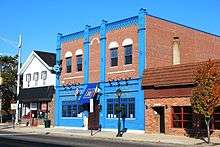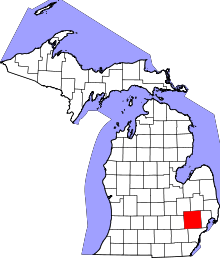Farmington, Michigan
| Farmington | |
|---|---|
| City | |
| City of Farmington | |
 Location in the state of Michigan | |
| Coordinates: 42°27′52″N 83°22′35″W / 42.46444°N 83.37639°WCoordinates: 42°27′52″N 83°22′35″W / 42.46444°N 83.37639°W | |
| Country | United States |
| State | Michigan |
| County | Oakland |
| Government | |
| • Type | Council-Manager |
| • Mayor | Bill Galvin |
| • City Manager | Vincent Pastue |
| Area[1] | |
| • City | 2.66 sq mi (6.89 km2) |
| • Land | 2.66 sq mi (6.89 km2) |
| • Water | 0 sq mi (0 km2) |
| Elevation | 751 ft (229 m) |
| Population (2010)[2] | |
| • City | 10,372 |
| • Estimate (2012[3]) | 10,479 |
| • Density | 3,899.2/sq mi (1,505.5/km2) |
| • Metro | 4,296,250 |
| Time zone | EST (UTC-5) |
| • Summer (DST) | EDT (UTC-4) |
| ZIP codes | 48331-48336 |
| Area code(s) | 248 |
| FIPS code | 26-27380[4] |
| GNIS feature ID | 0625837[5] |
| Website | http://www.ci.farmington.mi.us |
Farmington is a city in Oakland County of the U.S. state of Michigan. It is one of the northern suburbs of Detroit. As of the 2010 census, the city population was 10,372.[6] It is surrounded by Farmington Hills, except for a small portion bordered by Livonia to the south. Since 2009, the city's downtown has been the center of an extensive renovation and remodeling featuring a refacing or rebuilding of many buildings on Grand River Avenue, as well as brick paver sidewalks, the Farmington Pavilion, new lighting, and landscaping. The area is known for its historic downtown, elegant Victorian-style homes, and one of Michigan's top rated public school systems, Farmington Public Schools. In 2007 CNNMoney.com listed Farmington as number 55 in its Best Places to Live survey. Farmington was also ranked 27th on the list for Best to Live in 2013, citing nearly US$3 million in additional city renovations and development, bumping its rank up.[7][8]
History
Farmington was the site of three Native American trails - the Orchard Lake Trail, the Grand River Trail, and the Shiawassee Trail.[9]
Farmington was founded in 1824 by Arthur Power. Like many Oakland County pioneers, he hailed from the state of New York. Power was a Quaker, as were the settlers who joined him, and the town was first known as Quakertown. In 1826 the name Farmington was officially chosen because it was the name of Power's hometown, Farmington, New York.[10]
The name Farmington, which properly refers to the 2.7-square-mile (7.0 km2) municipality incorporated in the early 19th century, is sometimes erroneously used to refer to the 33.3-square-mile (86 km2) neighboring city of Farmington Hills (Farmington Township until 1973), which surrounds it.
In 1976 the National Register of Historic Places declared part of the city the Farmington Historic District.
Geography
According to the United States Census Bureau, the city has a total area of 2.66 square miles (6.89 km2), all of it land.[1]
Demographics
| Historical population | |||
|---|---|---|---|
| Census | Pop. | %± | |
| 1880 | 377 | — | |
| 1890 | 320 | −15.1% | |
| 1900 | 530 | 65.6% | |
| 1910 | 564 | 6.4% | |
| 1920 | 853 | 51.2% | |
| 1930 | 1,243 | 45.7% | |
| 1940 | 1,510 | 21.5% | |
| 1950 | 2,325 | 54.0% | |
| 1960 | 6,881 | 196.0% | |
| 1970 | 10,329 | 50.1% | |
| 1980 | 11,022 | 6.7% | |
| 1990 | 10,132 | −8.1% | |
| 2000 | 10,423 | 2.9% | |
| 2010 | 10,372 | −0.5% | |
| Est. 2015 | 10,523 | [11] | 1.5% |
2010 census
As of the census[4] of 2010, there were 10,372 people, 4,624 households, and 2,735 families residing in the city. The population density was 3,899.2 per square mile (1,505.5/km²). There were 4,959 housing units at an average density of 1,869.6 per square mile (721.7/km²). The racial makeup of the city was 71.5% White, 11.4% African American, 0.4% Native American, 13.9% Asian, 0.1% Pacific Islander, 0.4% from other races, and 2.1% from two or more races. Hispanic or Latino of any race were 2.1% of the population. There were 4,624 households of which 28.0% had children under the age of 18 living with them, 45.9% were married couples living together, 10.4% had a female householder with no husband present, and 40.9% were non-families. 35.9% of all households were made up of individuals and 13.7% had someone living alone who was 65 years of age or older. The average household size was 2.22 persons, and the average family size was 2.92.
In the city the population was spread out with 22.0% under the age of 18, 6.1% from 18 to 24, 29.4% from 25 to 44, 26.9% from 45 to 64, and 15.6% who were 65 years of age or older. The median age was 39.5 years. For every 100 females there were 89.4 males. For every 100 females age 18 and over, there were 87.1 males.
The median income for a household in the city was $56,442, and the median income for a family was $67,407. Males had a median income of $54,780 versus $39,435 for females (2000 Census). The per capita income for the city was $36,281. About 2.6% of families and 4.4% of the population were below the poverty line, including 5.5% of those under age 18 and 7.6% of those age 65 or over.[13]
Government
Farmington utilizes the council-manager form of government, and thus is governed by a city council consisting of a mayor and four council members. The city council appoints a city manager who manages the day-to-day operations of the city.
Farmington is surrounded by the city of Farmington Hills. The cities combine to form a district represented in Michigan's state government. Farmington is part of State Senate District 14, represented since 2009 by Democrat Vincent Gregory.
The Mayor of Farmington is Bill Galvin. Galvin was elected, by the council, to this position in November 2013.
Education
Farmington is served by the Farmington Public Schools. Farmington High School is one of the three high schools in the district. There are also parochial and private schools in the community.
Economy

A number of neighborhood and regional shopping centers are located within Farmington, and a traditional village downtown serves residents and the surrounding population.
Downtown Farmington has over 160 businesses that include large national retailers and small boutiques. Downtown Farmington's Sundquist Pavilion and Riley Park host the Saturday Farmers Market; Rhythmz in Riley Park, a free Friday summer concert series; and other activities.
The Farmington Plaza is located at the corner of Grand River and Mooney.
The Winery Building is located on the south side of Grand River Avenue just west of Orchard Lake Road and houses the "Haunted Winery" during the Halloween season.
The Drakeshire Plaza is located on Grand River Avenue, just east of Drake Road. In June 2007 the Drakeshire Plaza was approved by the City of Farmington for a substantial redevelopment of the center.
The Halsted Grand Shopping Center is named after its two crossroads.
Orchard Ten Plaza is a neighborhood shopping center located at the southwest corner of Orchard Lake and Ten Mile roads.
The World Wide Center has a number of small ethnic businesses. The center is located at the southwest corner of Grand River and Whittaker.
The Civic Theater is located in Downtown Farmington on Grand River just east of Farmington Road.
Media
In addition to The Detroit News and the Detroit Free Press, regional newspapers serving all of southeast Michigan, the city is served by two community newspapers. The Farmington Observer is published twice a week, on Sunday and Thursday. The Farmington Press is published weekly. The Oakland Press covers all of Oakland County.
Recognition
In 2007 CNNMoney.com listed Farmington as number 55 in their Best Places to Live survey.
Notable people
- Rex Cawley graduated from Farmington High School and was a gold medalist in the 1964 Tokyo Olympics.
- NHL goaltender Brent Johnson of the Pittsburgh Penguins is from Farmington.
- Mickey Harris was a MLB pitcher who died here in 1971.
- Michael Fougere, mayor of Regina, Saskatchewan was born here.
See also
References
| Wikimedia Commons has media related to Farmington, Michigan. |
- Specific
- 1 2 "US Gazetteer files 2010". United States Census Bureau. Retrieved 2012-11-25.
- ↑ "American FactFinder". United States Census Bureau. Retrieved 2012-11-25.
- ↑ "Population Estimates". United States Census Bureau. Retrieved 2013-06-03.
- 1 2 "American FactFinder". United States Census Bureau. Retrieved 2008-01-31.
- ↑ U.S. Geological Survey Geographic Names Information System: Farmington, Michigan
- ↑ "Race, Hispanic or Latino, Age, and Housing Occupancy: 2010 Census Redistricting Data (Public Law 94-171) Summary File (QT-PL), Farmington city, Michigan". U.S. Census Bureau, American FactFinder 2. Retrieved August 18, 2011.
- ↑ Ashford, Kate; Bartz, Andrea; Cox, Jeff; Fitch, Asa; Gandel, Stephen; Hyatt, Josh; Kelley, Rob; Knight, Kathleen; et al. "55. Farmington, Mich". CNN.
- ↑ "Farmington, MI - Best Places to Live 2013 - Money Magazine". CNN.
- ↑ http://www.farmlib.org/HeritageCollection/slideshow1.html
- ↑ Gannett, Henry (1905). The Origin of Certain Place Names in the United States. Govt. Print. Off. p. 124.
- ↑ "Annual Estimates of the Resident Population for Incorporated Places: April 1, 2010 to July 1, 2015". Retrieved July 2, 2016.
- ↑ "Census of Population and Housing". Census.gov. Retrieved June 4, 2015.
- ↑ 2010 census chart for Farmington
- General
- Wilkins, Korie (2006-12-19). "Merging Cities Debated". The Detroit Free Press. Archived from the original on 2007-03-26. Retrieved 2006-12-19.

